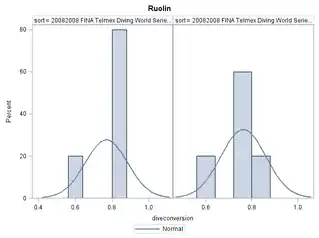*I apologize for the length of this post and I have almost no statistics experience, please keep that in mind :)
In competitive diving, a diver will perform 5 different dives and will receive scores from a panel of judges.
I have a theory that a diver is more likely to either perform the dive well and get a good score or mess up and receive a bad score, leading to a bit of a bi-modal distribution of scores. However, when I compared all divers at once, there was simply a normal(ish) distribution because the good divers' bad scores "cancel" with the bad divers' good scores(over simplification).
This lead me to separate all the data for a single person. But now I realize that because a diver's score changes with time/experience/age and also by event, this would lead to a "muddying" of the distributions. So to avoid eclipsing, what I believe will be a kind of bimodal distribution, I extracted data for a single person for each event type/round.
I have a distribution of dive scores from each dive for many different meets and rounds. (One person's data)
City Round Total_score Dive_1 Dive_2 ... Dive_5
NYC Finals 237 60.4 59.5
NYC Semis 199 62.7 60.1
LDN Prelim 356 65.1 57.35
From these, for each event(NYC Finals != NYC SemiFinals), I created a histogram to determine the frequency of different dive scores. Just by eyeing some of the histograms, it seems you are more likely to do well or badly than "okay".
 Note: Each graph corresponds to one event.
Note: Each graph corresponds to one event.
But I now need to use statistics to prove that I am not deluded. I was thinking of doing this by comparing the individual diver's yearly score's standard deviation to the individual event's deviation. From this I could derive an "expected" distribution and see if the individual event distributions are unlikely. However, I don't know if this is possible, or even makes sense to do. Are there any other ways of determining if a distribution is unlikely?
Once I have that(or something like it), I would need to repeat this analysis for every diver and then finally come to a conclusion of whether my hypothesis is correct.
*Edit: I am using SAS to analyze my data. Are there any built in procedures that could aid me?